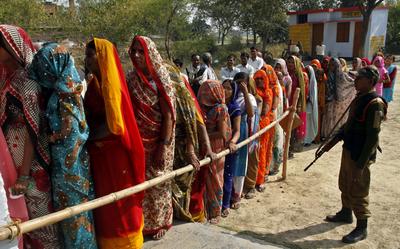But what can be said with some certainty is that no party is likely to win a majority on its own, and this will lead to a scramble for post-poll alliances.
Given its size, with a population of around 200 million, the UP elections always assume greater significance than those in other states. This time it has taken on additional importance for two reasons. First, the two dominant national parties — the Congress and the Bharatiya Janata Party (BJP) — have fared poorly in the state in recent times, so the current elections will be a test of strength for both. Second, the Congress is desperately shopping for allies at the federal level, since its largest coalition partner, the Trinamool Congress, has been persistently blocking major policy initiatives and voting against it in parliament. The two main players in UP — the Bahujan Samaj Party (BSP) and the Samajwadi Party (SP) — have both lent some ‘issue-based’ support to the government. Thus, in the likely event of a fractured mandate in UP, the Congress could ally itself with either the SP or the BSP — and in return bring either into the federal government, ensuring the marginalisation of the Trinamool Congress.
It is likely that the BSP — which in the last elections won an absolute majority with 206 out of 403 seats — will take a hit. The biggest black mark against the BSP is the perception that its leader, Mayawati (known as a champion of the Dalits, the caste traditionally referred to as untouchables), ran a very corrupt administration during her first full term as chief minister of UP. The biggest scandal to rock the state concerned the siphoning of funds from the National Rural Health Mission, a federal government scheme, and involved officials in 72 districts. In addition, Mayawati’s announcement late last year that UP would be split into four separate states does not seem to have resonated with voters in the way she hoped. Excessive spending on the construction of parks with giant statues of herself has also alienated many voters.
Despite all this, the BSP still remains a formidable force because of its popularity among the Dalits, who constitute 21.1 per cent of UP’s population. BSP’s good showing is in part due to its cobbling together of an unlikely collection of Dalits, Brahmins, Muslims and Most Backward Classes (MBCs) in the 2007 elections. The BSP’s list of candidates for 2012 mirrors this trend, as Mayawati is clearly hoping the formula will work for her again.
The BSP’s main rival, the SP, is likely to better its 2007 election tally of 97 seats. The SP draws it support from the Other Backward Classes — primarily the Yadavs — and Muslims, and is banking on its own caste calculus as well as anti-incumbency sentiment. The party is sticking to its tried and tested ways by giving nearly 50 per cent of its tickets to Yadavs and Muslims.
Meanwhile, the Congress has been reduced to a bit player in UP for the past decade, winning only 22 seats in the 2007 elections. The party is caught in a race with the SP to capture the state’s Muslim vote. But while the Congress has announced several concessions for Muslims, it is yet to shake off the taint of several events in recent years that turned Muslim opinion against the party. This time, the Congress is looking to radically improve its position. Its leader, Rahul Gandhi, is focusing on economic development, and the party is aggressively trying to attract the Muslim and the MBC votes. In addition, the Congress is the only major party that has gone for a pre-poll alliance, linking up with the Rashtriya Lok Dal (RLD). Opinion polls suggest the Congress will win 70 seats and the RLD another 15, making the combination a significant force to be reckoned with.
Like the Congress, the BJP’s fortunes have declined dramatically in UP, and its leaders will be desperate to take third place ahead of Congress. The BJP may marginally improve to win around 65 seats, giving it the opportunity to ally with the BSP if the need arises. But anything less than the Congress’ tally would be a setback for the BJP.
No party is likely to win a majority on its own. Depending on the election result, the BSP is likely to seek the support of the Congress or the BJP to form government. Alternatively, if the SP does well it could team up with the Congress. A hung verdict is not good news for UP voters, since coalition governments in the past have been unable to last their full term. But the worst case scenario would be that no party is able to form a government, provoking a spell of President’s rule before fresh elections. Observers will have to wait until 6 March, when results are announced, to find out which of these scenarios plays out in UP.
Ronojoy Sen is Visiting Research Fellow at the Institute of South Asian Studies, National University of Singapore.

